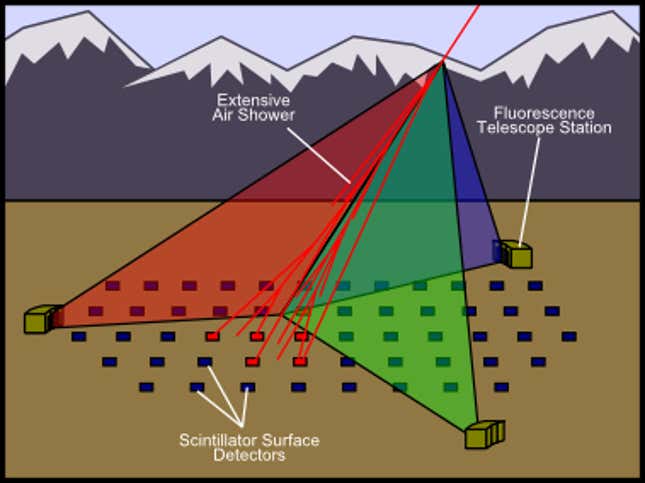Scientists from the Telescope Array Collaboration have detected an ultrahigh-energy cosmic ray, a discovery that’s difficult our present understanding of unique cosmic phenomena and their origins.
In a study revealed immediately within the journal Science, the Telescope Array Collaboration has reported the detection of an ultrahigh-energy cosmic ray (UHECR for brief), which displays an vitality stage of roughly 244 exa-electron volts, or roughly 40 Joules. This measurement, taken by a floor detector array in Utah, represents one of many highest vitality ranges ever noticed for cosmic rays. For context, this noticed vitality stage is roughly a million occasions greater than what probably the most highly effective human-made particle accelerators can produce, in keeping with the researchers.
The Telescope Array venture is a joint effort involving universities and establishments from america, Japan, Korea, Russia, and Belgium, and its objective is to watch “air showers” brought on by cosmic rays of extraordinarily excessive vitality. Unseen to the unaided eye, our planet is regularly bombarded with these cosmic rays, originating from each native sources inside our galaxy and distant extragalactic areas. To be clear, these area rays are nothing to fret about; Earth’s environment and magnetic subject supply efficient safety in opposition to cosmic rays, considerably lowering their potential to trigger hurt to people and different types of life.
The Telescope Array in Utah detects extraordinarily uncommon, high-energy cosmic rays utilizing a community of 507 detection stations unfold over 270 sq. miles (700 sq. kilometers). These stations seize secondary particles that type when cosmic rays hit the environment, creating in depth air showers (EAS). The system consists of plastic scintillators that glow when charged particles go via them and fluorescence detectors for measuring the vitality of the EAS. Information from the stations, analyzed utilizing GPS timing and simulations, helps decide the cosmic ray’s vitality, mass, and arrival course, regardless of their scarce prevalence.
Certainly, UHECRs just like the one described within the new research are extremely uncommon and thought to originate from probably the most energetic processes within the universe, similar to black holes and gamma-ray bursts. On account of their rare arrival—lower than as soon as per century per sq. kilometer—these cosmic rays necessitate giant detectors for statement. The Could 2021 occasion is due to this fact a giant deal for cosmic ray analysis.

The supply of this extragalactic cosmic ray, detected on Could 27, 2021, stays an enigma, as its incoming course doesn’t align with any identified astronomical objects. The cosmic ray’s arrival path, located close to the Milky Approach’s disk, means that it seemingly skilled solely minor deviations when zipping via magnetic fields (that are ubiquitous all through the galaxy, whether or not they be large-scale magnetic fields or localized magnetic fields generated by stars, supernova remnants, and different celestial objects). This implies the cosmic ray seemingly traveled virtually straight from the place it got here from, the researchers say.
That mentioned, its supply course doesn’t correlate with any identified galaxies or astronomical objects usually related to UHECRs. As a substitute, it seems to have originated from a void within the universe’s construction—an empty area with only a few galaxies. For you astronomy nerds on the market, it’s particularly the Native Void, an empty hole between the Native Group of galaxies and the close by Giant-Scale Construction filaments; only a few galaxies have been documented inside this void, none of which had been deemed succesful by the researchers of excreting such a robust cosmic ray.
Associated article: Hubble Snaps a Gorgeous Pic of the Universe’s Loneliest Galaxy
In response to the paper, the cosmic ray’s surprising incoming trajectory may very well be the results of it being considerably redirected by magnetic fields nearer to us, or it might need originated from a yet-to-be-discovered astronomical object close to the outskirts of our galaxy. Alternatively, this anomaly might reveal gaps in our present understanding of the physics governing such high-energy particles, the astronomers speculate.
To additional examine, the researchers in contrast the occasion with different noticed UHECRs above 100 exa-electron volts, or EeV, and located an isotropic distribution, which means these cosmic rays seem to come back from all instructions in area evenly, with out clustering. This isotropic sample provides one other layer of complexity in pinpointing their origins.
Traditionally, different high-energy cosmic rays have been detected, similar to a 320-EeV particle in 1991, a 213-EeV particle in 1993, and a 280-EeV particle in 2001, all within the Northern Hemisphere. The Southern Hemisphere has not recorded occasions above 166 EeV. These comparisons are very important for understanding the distribution and origin of such high-energy occasions, so hopefully future observations will present additional insights and doubtlessly reveal new patterns or sources.
Whereas this detection is essential for cosmic ray analysis, it raises extra questions than solutions concerning the origins and mechanisms of those high-energy particles. The findings from the Telescope Array experiment supply a brand new perspective on the mysteries of the universe, but in addition they underscore the vastness of our unknowns in astrophysics.
Extra: Highest-Energy Cosmic Radiation Comes From a Mysterious Source Beyond Our Galaxy
Trending Merchandise

Cooler Master MasterBox Q300L Micro-ATX Tower with Magnetic Design Dust Filter, Transparent Acrylic Side Panel, Adjustable I/O & Fully Ventilated Airflow, Black (MCB-Q300L-KANN-S00)

ASUS TUF Gaming GT301 ZAKU II Edition ATX mid-Tower Compact case with Tempered Glass Side Panel, Honeycomb Front Panel, 120mm Aura Addressable RGB Fan, Headphone Hanger,360mm Radiator, Gundam Edition

ASUS TUF Gaming GT501 Mid-Tower Computer Case for up to EATX Motherboards with USB 3.0 Front Panel Cases GT501/GRY/WITH Handle

be quiet! Pure Base 500DX ATX Mid Tower PC case | ARGB | 3 Pre-Installed Pure Wings 2 Fans | Tempered Glass Window | Black | BGW37

ASUS ROG Strix Helios GX601 White Edition RGB Mid-Tower Computer Case for ATX/EATX Motherboards with tempered glass, aluminum frame, GPU braces, 420mm radiator support and Aura Sync









